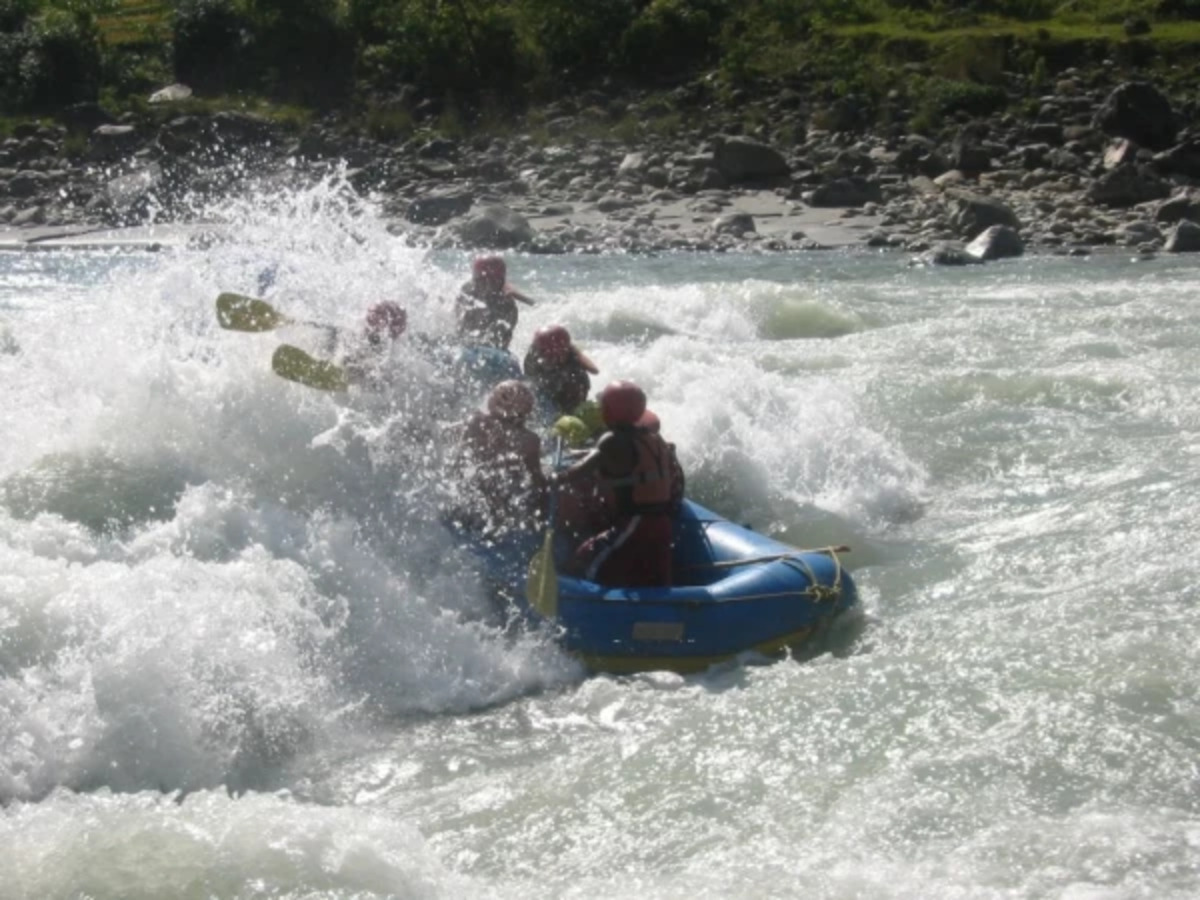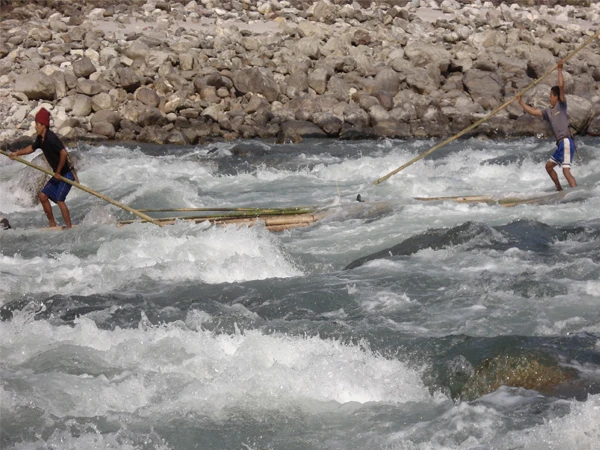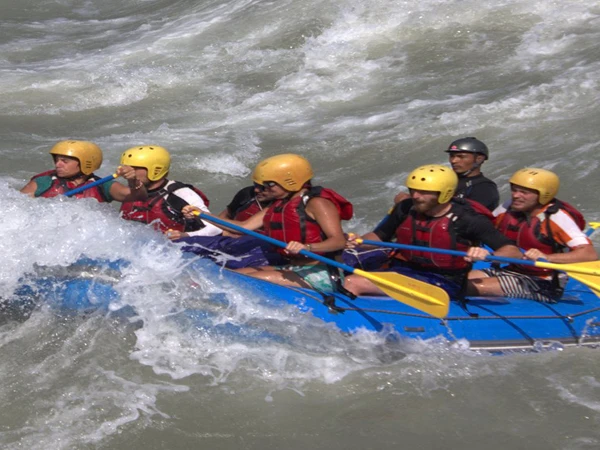Why is Timing Necessary for Rafting in Nepal?
Timing is everything for rafting activities as river conditions are significantly different with the season which has a direct impact on safety, the type of experience you will have and the views you will enjoy. The flow and level of water also vary throughout the year and rafting at the incorrect time will yield dangerous conditions or an undesirable experience.
Heavy monsoon showers between June to August make the rivers reach their peak water levels, making the rapids unpredictable. Floods are possible along with turbulent rapids and little visibility, rendering the rafting activity challenging and unsafe. During spring and autumn, however, the waters are well controlled and the rapids during this time are thrilling yet manageable for an enjoyable and safe trip.
For those who prefer it mellow, winter or early spring is the best time to go rafting in Nepal. You can enjoy a relaxed and peaceful rafting experience when rivers are at their calmest flows and water levels are low. For the purpose of making your rafting trip even more thrilling, you must try rafting either in spring or autumn. During these seasons, the river water is at their best levels which provide the ideal balance between safety and excitement.
Besides, spring and autumn are the times when Nepal's natural beauty is at its peak with green forests, blooming flowers and blue skies contributing to the visual beauty of your journey. These periods offer the finest combination of beautiful natural scenery and rafting experience with an adrenaline kick.
On the other hand, winter introduces you to less crowded, serene rivers which can be taken as an opportunity to travel to far flung river areas and experience a more personal touch with nature and regional culture. However, the cold climate may limit the comfort and convenience of the journey.

White Water Rafting in Nepal in Different Seasons
Spring
Spring is one of the peak seasons for white water rafting in Nepal. The weather during this season is delightful to undertake the thrilling rafting experience in diverse, alluring rivers of Nepal. The temperature ranges from 15 to 25 degrees Celcius at this time making it perfect for outdoor activities.
Spring has the best rafting conditions with moderate and stable water levels. The streams get an adequate supply from the winter snow melting to offer exciting but not overly challenging rapids. Further, the new plant growth, blooming flowers and clear waters offer a mesmerizing spectacle to the rafting tours. This beautiful natural scenery and adrenaline infused rapids offer a rich and unforgettable experience of your water trip.
Summer
Summer is a monsoon season in Nepal with heavy rain, high humidity and hot weather. It is not ideal to go rafting at this time due to the inconvenience brought by the poor weather conditions.
Monsoon weather hinders visibility and makes rafting uncomfortable. However, after rain, the sky opens up and the surrounding landscape appears fresh with awe inspiring views of the Himalayas and green valleys.
The heavy and recurrent monsoon rains in summer cause high water levels in all rivers, making them dangerous for rafting. The challenging rivers like Trishuli and Bhote Koshi experience wild water flows and unpredictable rapids which increase the chances of accidents. Since the water levels fluctuate suddenly and the risk of floods increases, rafting is too risky for even the most experienced rafters during this time.
Autumn
Autumn is the other peak rafting season in Nepal. Clear sky, moderate temperatures and exhilarating rapids characterize the autumn season making it one of the best seasons to raft.
After the monsoon rains, the rivers subside to normal and the weather is fresh and comfortable. The water levels are neither too low nor too high. However, they are full of exhilarating rapids where in rivers like Seti, Trishuli and Kali Gandaki you can enjoy aderline pumping rides. The flow of water is just appropriate, providing the right amount of adventure and safety to the rafters.
Winter
Winter is the off-season for rafting, but it can also be a wonderful experience, especially for those who prefer less crowds and cooler weather. Water levels are usually low in winter thereby reducing the force of the rapids. This is perfect for those who would like a less challenging rafting experience. However, for adrenaline enthusiasts, there are some rivers that provide thrilling rapids such as Trishuli and Kali Gandaki.
Winter is not too touristy unlike the peak seasons of spring and autumn. Fewer tourists mean a more personalized and peaceful rafting experience. This lets you have a better sense of the peacefulness of the river and the surrounding environment without the distraction of large crowds.
Winter temperatures fall sharply, especially during mornings and evenings, by 5 to 15 degrees Celsius at lower elevations. The Unpleasant cold weather may not be comfortable for everyone but the absence of crowds and peaceful surroundings makes the rafting trip quieter and enjoyable.
Why Raft in Nepal During Spring and Autumn?
White water rafting in Nepal is an exhilarating experience on some of the world's most beautiful rivers. The best time for rafting in Nepal varies on a variety of factors including the state of the rivers, the climate and safety. The spring and autumn seasons offer the right balance of safety, excitement and amazing scenery for a memorable rafting experience.
Ideal Water levels
The water level in rivers is at its best in spring and fall. Between the melting of winter snows and the overflow of monsoon rains, the river sees moderate water levels and smooth flow, forming thrilling rapids but not dangerous enough. These are the best times for a thrilling but safe rafting trip with the water just being enough to form currents without being too overwhelming.
Delightful Weather
Spring and autumn both provide pleasant weather making these periods ideal for exploring the outdoors. The weather is comfortable which is not too hot as in summer or too chilly as in winter enabling rafters to enjoy the excursion without being exposed to extreme weather. Spring provides warmth and rejuvenation and autumn provides coolness and freshness that are ideal for an energized day on the water.
Scenic Beauty
You can see the natural beauty of Nepal in its full glory in spring and autumn. In spring, the rivers are bordered with greenery and blooming flowers. Autumn is noted for fresh air and clear blue skies. The scenic landscape surrounding the rivers complements the rafting experience, providing rafters with not just an adrenaline rush but also a chance to appreciate some of the world's most spectacular landscapes.
Lower Risk of Floods
Autumn and spring are optimum times for safe rafting trips. Coming right before (spring) and after (autumn) the challenging monsoon, you can skip its extremes and enjoy dry conditions with moderate water levels.
Monsoon season from June to August is characterized by heavy rains that fill the rivers with water and cause stormy rapids to form. The likelihood of floods and powerful, uncontrolled rapids is greatly increased at this time. On the other hand, being the pre monsoon and post monsoon season, spring and autumn provide consistent river conditions, making lethal water flow unlikely and rafting more secure.
Mix of Rapids
The rivers in spring and fall provide the ideal combination of excitement, adventure and relaxation for rafters. If you are looking for raging rapids or a leisurely float through scenic riverside these seasons provide both. Rivers such as the Trishuli and Seti provide exhilarating rapids for the thrill seekers while others provide a slower ride for those who want to take in the scenery and unwind.

Nepal Rafting: Adventures for All
For First Timers
For beginners, Nepal offers calm rivers with tranquil water and gentle rapids. These are ideal to introduce beginners to the basics of rafting in a safe and controlled setting. The ideal times for beginners to raft are spring and autumn when the weather is pleasant and the rivers are not too challenging.
For Experienced
Nepal's rivers provide the perfect challenge for experienced rafters. With wild white water rapids and cliff drops, rafters can have their adrenaline bursting at its best. The monsoon period is ideal to test your rafting skills to the core while riding the forceful, high-energy rapids. However, a selection of seasoned guides and understanding the river condition, whether or not it is in the right state to raft, is necessary.
For Comfort Seekers
Comfort travelers can indulge in rafting vacations where the thrill of the ride is mixed with first-class luxury and convenience. Top notch accommodations, gourmet food and easy transportation allow for an indulgent rafting vacation. Spring and autumn are perfect seasons for such a vacation as the weather conditions are ideal for effortless rafting down serene rivers. The focus of this vacation is on comfort with a mix of adventure and relaxation.
For Budget Rafters
Rafting on a tight budget is particularly best to go on during the monsoon or winter when off season discounts will lower the cost of trips. Budget trips may have less of a luxury feel to their accommodation and cuisine but still a great deal of adventure and excitement in rafting activities.
For Photographers and Nature Lovers
Nature lovers and photographers will delight in the scenic rafting on Nepal's untouched rivers with a grand sight of waterfalls, mountains and forests. Spring and autumn are the best time for rafting in Nepal to witness its beauty to its fullest. The sunny blue skies, blossoming flowers and colored foliage present the perfect scenario for photography and appreciating the grandeur of nature at these periods.
For Culture Explorers
Culture explorers will find rafting in Nepal to be a rewarding experience that provides adventure along with exposure to the local region's traditions. In the period of rafting, you can also visit the riverside villages and cultural attractions allowing you to interact with the locals, see how they live and know what culture they follow. The ideal time to explore culture is in spring and autumn when there is festive atmosphere and the weather is also ideal for outdoor activities.
For Crowds or Solitude Seekers
For those who enjoy the company of others, rafting on popular rivers like the Trishuli and Bhote Koshi, which are easily accessible, is ideal, especially during the busy spring and fall seasons
If you want solitude, rivers like the Karnali or Tamur offer an isolated experience. Winter or monsoon is best for people seeking a tranquil rafting experience in quiet environments.
Tips for Safe and Enriching Rafting Trips in Nepal
- Wear synthetic or moisture wicking clothing for comfort and a splash suit for extra warmth.
- Pack gloves and a warm hat along with thermal clothing to wear under your splash suit while rafting during winter.
- Stay hydrated since rafting is an activity that involves a lot of physical exertion.
- Take sunglasses, sunscreen and a hat as protection against the strong daytime sun.
- Better avoid rafting adventures during monsoon season as excessive rain may cause flooding and unpredictable water levels.
- Keep a daily observation of river conditions as water levels significantly increase and decrease owing to weather changes. As well as keep track of the weather forecasts.
- Carry warm clothing for early mornings and evenings.
- Carry a camera to snap pictures of beautiful river scenery and your adventurous rafting experience.
- Book in advance to make sure rafting is available especially during spring and autumn which are the peak rafting season.
- Raft on calm rivers for a smoother and pleasant experience.
- Choose a licensed rafting outfitter with knowledgeable guides who emphasize safety and have deep river experience.
- Wear a well-fitting life jacket, a safety helmet and strap watershoes.
- Nepal offers rivers for beginner, intermediate and advanced rafters. Choose a river to raft according to your skill and experience level.
- Get acquainted with the river's situation such as the rapids, flow of water and any obstacles. This both psychologically and physically prepares you.
- Always listen to your guide's safety briefings before and throughout the trip. This includes paddling commands, emergency approaches and procedures if you fall off the raft.
- Purchase comprehensive travel insurance that covers rafting and any other adventure sport you will be undertaking.
- Always trust your guide's expertise to keep you safe and secure In case of any unexpected event.









